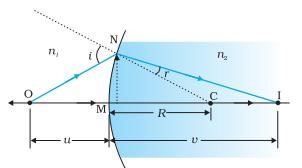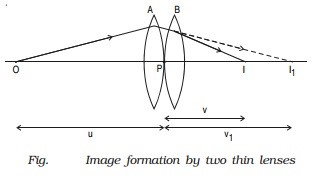Ray optics is a model of optics that describes light propagation in terms of rays. The ray in geometric optics is an abstraction useful for approximating the paths along which light propagates under certain circumstances.
A spherical mirror is that mirror whose reflecting surface is the part of a hollow sphere of glass. Spherical mirrors are of two types
The radius of Curvature (c): It is the distance between Pole and the Center of curvature.
Center of Curvature (r): The Center of Curvature of a spherical mirror is the point in the center of the mirror which passes through the curve of the mirror and has the same tangent and curvature at that point.
Aperture: It is a point from which the reflection of light actually happens.
Pole (p): Pole is the midpoint of a mirror. It’s twice the focus.
Focus: It is any point, where light rays parallel to the principal axis, will converge after reflecting from the mirror.
Principal axis: An imaginary line passing through the optical center and the center of curvature of the spherical mirror.
Focal Length: It is on the axis of a mirror where rays of light are parallel to the axis converge after reflection or refraction.
A sign convention is a choice of the physical significance of signs (plus or minus) for a set of quantities, in a case where the choice of sign is arbitrary.
The distance from the pole to the focal point is called the focal length (f). The focal length of a spherical mirror is then approximately half its radius of curvature.
Mirror formula is the relationship between object distance (u), image distance (v) and focal length.
In principle, we can take any two rays emanating from a point on an object, trace their paths, find their point of intersection and thus, obtain the image of the point due to reflection at a spherical mirror. In practice, however, it is convenient to choose any two of the following rays:
(i) The ray from the point which is parallel to the principal axis. The reflected ray goes through the focus of the mirror.
(ii) The ray passing through the centre of curvature of a concave mirror or appearing to pass through it for a convex mirror. The reflected ray simply retraces the path.
(iii) The ray passing through (or directed towards) the focus of the concave mirror or appearing to pass through (or directed towards) the focus of a convex mirror. The reflected ray is parallel to the principal axis.
(iv) The ray incident at any angle at the pole. The reflected ray follows laws of reflection.
Refraction is the bending of a wave when it passes from one medium to another. The bending is caused due to the differences in density between the two substances.
Snell experimentally obtained the following laws of refraction:
(i) The incident ray, the refracted ray and the normal to the interface at the point of incidence, all lie in the same plane.
(ii) The ratio of the sine of the angle of incidence to the sine of angle of refraction is constant. Remember that the angles of incidence (i ) and refraction (r ) are the angles that the incident and its refracted ray make with the normal, respectively.
When light travels from an optically denser medium to a rarer medium at the interface, it is partly reflected back into the same medium and partly refracted to the second medium. This reflection is called the internal reflection.
(i) Mirage: On hot summer days, the air near the ground becomes hotter than the air at higher levels. The refractive index of air increases with its density. Hotter air is less dense, and has smaller refractive index than the cooler air.
(ii) Diamond: Diamonds are known for their spectacular brilliance. Their brilliance is mainly due to the total internal reflection of light inside them. The critical angle for diamond-air interface (≅ 24.4°) is very small, therefore once light enters a diamond, it is very likely to undergo total internal reflection inside it.
(iii) Prism: Prisms designed to bend light by 90° or by 180° make use of total internal reflection.
(iv) Optical fibres: Nowadays optical fibres are extensively used for transmitting audio and video signals through long distances. Optical fibres too make use of the phenomenon of total internal reflection.
Consider refraction at a spherical interface between two transparent media. An infinitesimal part of a spherical surface can be regarded as planar and the same laws of refraction can be applied at every point on the surface.

The rays are incident from a medium of refractive index n1, to another of refractive index n2.
Assuming the aperture (or the lateral size) of the surface to be small compared to other distances involved, so that small angle approximation can be made.
Consider NM will be taken to be nearly equal to the length of the perpendicular from the point N on the principal axis.
A ray of light incident on the lens parallel to the principal axis after refraction passes through second principal axis. A ray of light passing through first principal focus after refraction should move parallel to the principal axis. A ray of light passing through the optical centre should go-undeviated after refraction.
The ability of a lens to bend the light falling on it is called the power of a lens. Since the lens of shorter focal length will bend the light rays more will have more power. A convex lens converges the light rays towards the principal axis whereas a concave lens diverges the light rays away from the principal axis.
Let us consider two lenses A and B of focal length f1 and f2 placed in contact with each other. An object is placed at O beyond the focus of the first lens A on the common principal axis.
The lens A produces an image at I1 . This image I1 acts as the object for the second lens B. The final image is produced at I as shown in Fig. Since the lenses are thin, a common optical centre P is chosen.

Let PO = u, object distance for the first lens (A), PI = v, final image distance and PI1 = v1, image distance for the first lens (A) and also object distance for second lens (B).
A glass prism is a transparent object having two triangular ends and three rectangular sides. The refraction of light in glass prism is different from a glass slab. This is because in glass prism, the incident ray of light is not parallel to emergent ray of light. When a ray of light enters the glass prism it gets deviated two times. First when it enters the glass prism and second when it comes out of the prism. This is because the refracting surfaces of the prism are not parallel to each other. Also, when the ray of light passes through the prism it bends towards its base.
When white light is passed through a glass prism it splits into its spectrum of colours (in order violet, indigo, blue, green, yellow, orange and red) and this process of white light splitting into its constituent colours is termed as dispersion.

The variation of refractive index with wavelength may be more pronounced in some media than the other. In vacuum, of course, the speed of light is independent of wavelength. Thus, vacuum (or air approximately) is a non-dispersive medium in which all colours travel with the same speed. This also follows from the fact that sunlight reaches us in the form of white light and not as its components. On the other hand, glass is a dispersive medium.
The rainbow is an example of the dispersion of sunlight by the water drops in the atmosphere. This is a phenomenon due to combined effect of dispersion, refraction and reflection of sunlight by spherical water droplets of rain. The conditions for observing a rainbow are that the Sun should be shining in one part of the sky (say near western horizon) while it is raining in the opposite part of the sky (say eastern horizon). An observer can therefore see a rainbow only when his back is towards the Sun.
As sunlight travels through the earth’s atmosphere, it gets scattered (changes its direction) by the atmospheric particles. Light of shorter wavelengths is scattered much more than light of longer wavelengths. (The amount of scattering is inversely proportional to the fourth power of the wavelength. This is known as Rayleigh scattering). Hence, the bluish colour predominates in a clear sky, since blue has a shorter wave-length than red and is scattered much more strongly. In fact, violet gets scattered even more than blue, having a shorter wavelength. But since our eyes are more sensitive to blue than violet, we see the sky blue.
A number of optical devices and instruments have been designed utilising reflecting and refracting properties of mirrors, lenses and prisms. Periscope, kaleidoscope, binoculars, telescopes, microscopes are some examples of optical devices and instruments that are in common use.
The eye is perhaps the most interesting of all optical instruments. The eye is remarkable in how it forms images and in the richness of detail and color it can detect. However, our eyes commonly need some correction, to reach what is called “normal” vision, but should be called ideal rather than normal. Image formation by our eyes and common vision correction are easy to analyze with the optics discussed in Geometric Optics.
Microscope, instrument that produces enlarged images of small objects, allowing the observer an exceedingly close view of minute structures at a scale convenient for examination and analysis. Although optical microscopes are the subject of this article, an image may also be enlarged by many other wave forms, including acoustic, X-ray, or electron beam, and be received by direct or digital imaging or by a combination of these methods. The microscope may provide a dynamic image (as with conventional optical instruments) or one that is static (as with conventional scanning electron microscopes).
A telescope is an optical instrument using lenses, curved mirrors, or a combination of both to observe distant objects, or various devices used to observe distant objects by their emission, absorption, or reflection of electromagnetic radiation. The first known practical telescopes were refracting telescopes invented in the Netherlands at the beginning of the 17th century, by using glass lenses. They were used for both terrestrial applications and astronomy.
| Article and Schedule Quiz | Start Test! |